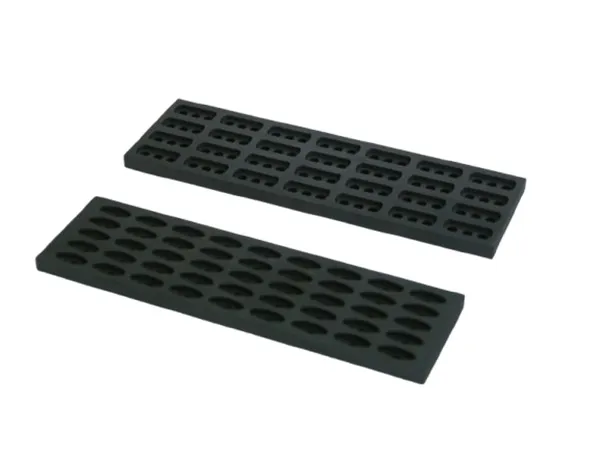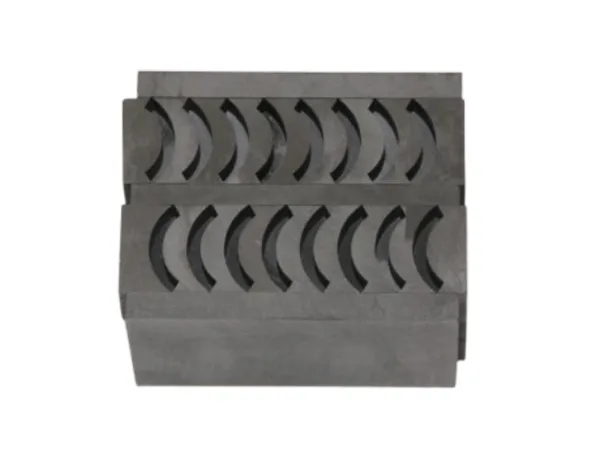Time: 2025-07-07 04:33:42 Source: Cangzhou Carbon Technology Co., Ltd.
Graphite molds are widely used in metal casting, glass molding, electronic metallurgy and other fields, due to its excellent high temperature resistance, chemical stability and good thermal conductivity is widely adopted. However, after experiencing high temperature casting process, the surface of the mold will often residual metal oxides, carbides, lubricant residues or other impurities, if not cleaned in a timely manner, will not only affect the accuracy of the mold and the quality of the surface, but also accelerate the aging of the mold, shorten the service life.
Cleaning graphite molds after casting is crucial for maintaining their performance and extending their lifespan.

Extend the life of the mold: removing residue reduces heat stress buildup and chemical corrosion;
Ensure casting quality: a clean mold surface enhances the finish of the next round of casting;
Avoiding dimensional errors: mold residues may cause molding deviations;
Improve productivity: avoid scrap or rework due to contamination.
Mechanical cleaning
Use soft bristle brush or plastic scraper to remove surface impurities;
For thicker residues, micro-sand blasting (low-pressure sand blasting) can be used.
Heat treatment cleaning
The mold is placed in an oven and heated to break down the attached organic impurities;
Often used in conjunction with an inert gas atmosphere (e.g. nitrogen) to avoid oxidation.
Chemical Cleaning
Soak or scrub the graphite surface with a non-corrosive cleaning solution;
Avoid the use of solutions containing strong acids or bases that may damage the graphite structure.
Ultrasonic cleaning (precision molds)
Suitable for micro-fine structure molds, can effectively remove tiny particles;
It is better to use with neutral solution.

Never clean a hot mold with cold water or in a cold environment. This can cause thermal shock, leading to cracking or damage. Let the mold cool down naturally to a safe handling temperature.
2. Remove Loose Debris:
Brush or wipe away any loose slag, metal particles, or other debris.
Use a soft-bristle brush or a clean, lint-free cloth.
Avoid using steel or hard brushes/scrapers as these can scratch the graphite surface, affecting future casts and reducing mold life. If something is stuck, try a wooden or plastic scraper.
3. Address Stubborn Residues (Slag, Flux):
Gentle Heating: If some residue remains stuck after brushing, gently heat the mold at a low temperature. This can soften the debris, making it easier to remove without damaging the graphite. Do not use high temperatures.
Chemical Cleaning (Use with Caution): For very persistent impurities, chemical cleaning might be an option, but it's crucial to be very careful.
Identify the contaminant: Different residues may respond to different chemicals. For example, metal particles are usually removed mechanically, while oxides or residues might benefit from chemical cleaning.
Choose appropriate chemicals: Use soft acids or specialized cleansers designed for crucibles that dissolve oxides and slag without corroding graphite. Avoid highly corrosive chemicals like strong acids or alkalis, as they can wear away the graphite surface.
Consult the manufacturer: If you're unsure, always consult the mold manufacturer for recommendations on safe cleaning agents.
Wear protective gear: Always wear gloves, goggles, and other protective equipment when handling chemicals.
Application: Spread the chemical cleaner inside the mold and allow it to sit for the recommended time to dissolve contaminants.
Thorough rinsing: After chemical treatment, rinse the mold thoroughly with clean or distilled water to remove all traces of chemicals and contaminants. Tap water can leave mineral deposits.
Complete drying: Ensure the mold is completely dry before storing or reusing. Any remaining water can react with the graphite or affect the next casting. You can let it air dry in a clean, dry environment or gently dry it with a lint-free cloth.
4. Surface Maintenance (Optional but Recommended):
Smoothing/Polishing: For high-precision casting where surface quality is critical, you can smooth or polish the mold surface. This can be done manually or mechanically using abrasive pads or polishing wheels. Start with a coarser grit for major imperfections and finish with a finer grit for a smoother surface. For intricate areas, rotary tools can be helpful.
Graphite Coating: Some casters apply a graphite coating to further refine the finish, which can improve mold release and resistance to oxidation and wear.
General Tips for Maintaining Graphite Molds:
Preheating: Always preheat your graphite mold before casting. This drives off any absorbed moisture (which can cause issues like explosions with molten metal) and helps prevent thermal shock to the mold. You can often preheat the mold by placing it near your crucible or furnace while the metal is melting.
Avoid banging the mold: When removing a casting, avoid forcefully banging the mold, as this can cause damage.
Proper Storage: Store clean and dry graphite molds in a clean, dry environment to prevent moisture absorption and contamination.
One metal per mold/crucible (if possible): To avoid cross-contamination, it's a good practice to designate specific molds for specific metals.
By following these guidelines, you can ensure your graphite molds remain in good condition for many successful castings.